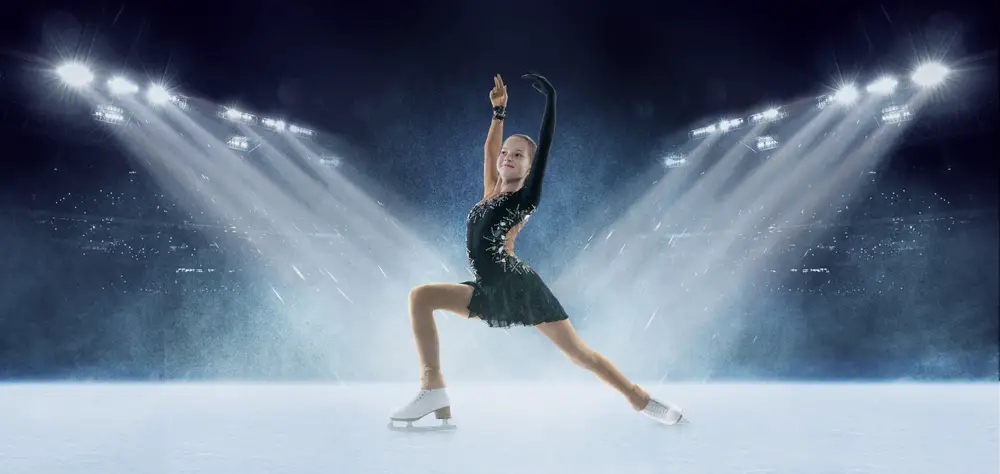Figure skating is one of the most technical sports in the world. This is because it combines the grace, precision and strength of the skaters, who perform choreographed movements to the sound of music, enchanting judges and audiences alike.
In order for the sport to be better appreciated, whether by the athletes or the audience watching, it is crucial that the rules are obeyed. With this in mind, we’ve put together a special article on the rules of figure skating!
Get to know everything from the structure and size of the venue in which the competitions take place, to the way in which scores are calculated. Get your notes together and get ready to check out the main rules of figure skating!
Open your Betano account and get up to R$1,000 in bonuses.
PIX payments, live games and super odds!
Click here to open your account!

Figure skating rules: complete list
- Competition rink;
- Duration;
- Scoring;
- Competitors;
- Infractions and penalties;
- Clothing and equipment;
- Categories;
- Elements;
- Music and choreography.
Figure skating rules: competition rink
The surface of a figure skating rink is usually ice, but it can also be made of synthetic material.
The official dimensions of an Olympic rink are 60 meters long and 30 meters wide. However, for local or regional competitions, the dimensions can vary, as long as the surface is suitable for performing technical and choreographic movements.
The quality of the ice is an important factor in the creation of the rink, which must be smooth, even, without cracks or holes. These details can pose a risk of falls or even hinder the athletes’ performance.
The temperature of the ice must be kept between -5°C and -3°C, ensuring the ideal consistency for the sport.
Figure skating rules: duration
In figure skating, competitions are generally divided into short programs and long programs. Here’s how it works!
- In the short program, skaters have a limited time of approximately 2 minutes and 40 seconds to perform a series of compulsory elements.
- In the long program, also known as the free program, the series lasts between 4 minutes and 4 minutes and 30 seconds for men, and between 3 minutes and 50 seconds and 4 minutes for women.
It is crucial that skaters respect these times, as penalties can be applied to those who exceed or fail to reach the set time.
Timing, then, begins with the skater’s first movement and ends with the last final pose.
Figure skating rules: scoring
Scoring in figure skating combines technical evaluation and artistic presentation. The most widely used judging system today is the International Judging System (IJS), applied to replace the old 6.0 grading system.
Each technical element, such as jumps, spins and steps, is given a points base that can be adjusted based on execution.
Therefore, the score is divided into two main categories: the Technical Elements Score (TES) and the Program Components Score (PCS).
The TES evaluates the difficulty and quality of the technical elements, while the PCS considers aspects such as the interpretation of the music, the choreography, the performance and the transition between movements.
Figure skating rules: competitors
Figure skating can be practiced individually, in pairs or in groups:
- In individual competitions, one skater performs alone;
- In pair competitions, a couple (a man and a woman) perform synchronized movements, lifts and throws.
In addition, there are group skating competitions, known as “synchronized skating”, in which teams of eight to 20 skaters perform synchronized movements, forming figures and performing complex steps together.
Figure skating rules: infractions and penalties
Check out the main infractions and penalties in figure skating:
- Falls: each fall results in a deduction of points.
- Leaving the track: if a skater leaves the boundaries of the track, they are penalized.
- Exceeding time: exceeding the time allowed for the performance is prohibited.
- Technical faults: mistakes made in the execution of technical elements, such as incomplete jumps or poorly executed spins, also result in penalties.
The judges are responsible for identifying these infractions and applying the penalties.
Figure skating rules: clothing and equipment
Skaters’ clothing and equipment are regulated to ensure not only the aesthetics of the competitors.
Clothes must be elegant and appropriate for the music and choreography, but also functional, allowing freedom of movement when performing. The use of accessories is allowed, but must be limited so as not to get in the way.
Skates must be well adjusted and suited to the skater’s technical level. Sharp, good quality blades are essential for a good performance.
Figure skating rules: categories
Figure skating competitions are divided into various categories and types, depending on the age and level of the competitors. Check out the main ones:
- Juvenile: for younger skaters.
- Junior: for developing skaters aged between 13 and 19.
- Senior: this is the main category, for elite skaters, usually aged 20 or over.
There are also specific competitions for veterans and for skaters with special needs.
Figure skating rules: elements
Figure skating programs have both compulsory and free elements. Here’s how it works!
- In the short program, there is a list of elements that all skaters must perform, such as jumps, spins and step sequences.
- In the free program, skaters have more freedom to choose the elements, allowing for greater artistic expression and use of creativity.
The combination of compulsory and free elements ensures that skaters demonstrate both technique and creativity in their performances.
Figure skating rules: music and choreography
The choice of music and choreography are extremely important in figure skating. The music must be appropriate to the performance being presented, and the choreography must be developed to highlight the skater’s strengths. The music can be instrumental or vocal, but it must comply with the competition rules.

Figure skating rules: complete list
- Competition rink;
- Duration;
- Scoring;
- Competitors;
- Infractions and penalties;
- Clothing and equipment;
- Categories;
- Elements;
- Music and choreography.
These are the rules of figure skating! If you enjoyed learning about the sport with this content, take advantage of the fact that you’ve come this far and explore our other articles on the world of sport!



